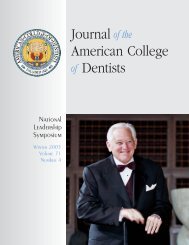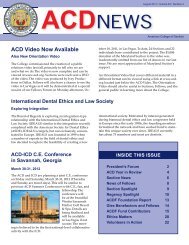Journal of the American College of Dentists
Journal of the American College of Dentists
Journal of the American College of Dentists
Create successful ePaper yourself
Turn your PDF publications into a flip-book with our unique Google optimized e-Paper software.
Students’ Views on Ethics<br />
24<br />
Hollywood, advertising, and <strong>the</strong><br />
media are all key players in <strong>the</strong> conception<br />
<strong>of</strong> <strong>American</strong> consumer culture.<br />
<strong>American</strong> dentists are selling <strong>the</strong>ir<br />
es<strong>the</strong>tic work as a necessity, calling <strong>the</strong><br />
smile, “<strong>the</strong> ultimate fashion accessory”<br />
(Paulus, 2010). The very word “fashion”<br />
implies a cycling <strong>of</strong> products to be<br />
bought and discarded when <strong>the</strong>y are<br />
out <strong>of</strong> fashion and thus closely mirrors<br />
<strong>the</strong> throw-away society created by <strong>the</strong><br />
mass production-consumption economy.<br />
O<strong>the</strong>r values from <strong>the</strong> consumer culture<br />
such as prestige, beauty, acquisition,<br />
and self-adornment still ring true when<br />
thinking about today’s smile in its<br />
association with attractiveness, vigor,<br />
youth, health, and wealth. The <strong>American</strong><br />
smile has become a name brand in global<br />
dentistry and <strong>the</strong> trademark label is<br />
stamped across patients’ faces.<br />
The consumer mentality in <strong>the</strong><br />
United States places a price tag on <strong>the</strong><br />
smile, similar to that <strong>of</strong> a car, and thus<br />
makes it an item <strong>of</strong> social status. In<br />
1899, Thorsten Veblen published The<br />
Theory <strong>of</strong> <strong>the</strong> Leisure Class in which<br />
he coined <strong>the</strong> term “conspicuous consumption,”<br />
meant to describe excessive<br />
expenditure <strong>of</strong> money and resources<br />
to outwardly display a higher social<br />
status. Since Veblen’s documentation<br />
<strong>of</strong> this phenomenon at <strong>the</strong> beginning<br />
<strong>of</strong> <strong>the</strong> twentieth century, conspicuous<br />
consumption continues unabated in<br />
America, as seen in brand-name labels<br />
on clothing, types <strong>of</strong> cars, and leisure<br />
activities. These are all items viewed<br />
socially, indicating that <strong>the</strong>y are not<br />
necessarily meant for utility, but ra<strong>the</strong>r<br />
for expression <strong>of</strong> social status. It has<br />
been noted that <strong>the</strong> body has become a<br />
form <strong>of</strong> physical capital—a possessor<br />
<strong>of</strong> power, status, and distinctive forms<br />
central to <strong>the</strong> accumulation <strong>of</strong> various<br />
resources meant to attain social status.<br />
The idea <strong>of</strong> Veblen-goods can also be<br />
extended to es<strong>the</strong>tic dentistry in that<br />
much <strong>of</strong> it is not driven by <strong>the</strong> utility <strong>of</strong><br />
<strong>the</strong> procedure, but more so <strong>the</strong> vanity<br />
<strong>of</strong> <strong>the</strong> patient wishing to attain an image<br />
<strong>of</strong> health, vigor, and wealth culturally<br />
associated with teeth as described above.<br />
Cosmetic dental procedures <strong>of</strong> today are<br />
clear extensions <strong>of</strong> Veblen’s observations<br />
<strong>of</strong> <strong>the</strong> <strong>American</strong> economy.<br />
Finally, <strong>the</strong> consumer culture machine<br />
created an increasingly self-conscious<br />
generation <strong>of</strong> people where media-created<br />
insecurities can be addressed by <strong>the</strong><br />
consumption <strong>of</strong> es<strong>the</strong>tic dentistry. The<br />
urge to consume was actually made into<br />
a national priority in a Calvin Coolidge<br />
speech to advertisers in 1926 where he<br />
mentioned <strong>the</strong> need to induce in people<br />
<strong>the</strong> desire for better things (Ewen, 1976).<br />
<strong>American</strong> marketing <strong>of</strong> dental beauty<br />
as an unnaturally white, straight, symmetrical<br />
smile creates its own demand.<br />
<strong>Dentists</strong>, dental supply companies, and<br />
es<strong>the</strong>tic procedures provide <strong>the</strong> supply.<br />
This kind <strong>of</strong> advertising, as seen almost<br />
in all aspects <strong>of</strong> <strong>American</strong> goods, glorifies<br />
an unnatural smile as healthy and happy<br />
and suggests that anyone without it is<br />
in need <strong>of</strong> treatment.<br />
<strong>American</strong> consumer culture as<br />
developed in <strong>the</strong> early 1900s has created<br />
a cultural push for a “piano key” smile,<br />
an interest in displaying status through<br />
cosmetic dental procedures, and a<br />
market that is based on <strong>the</strong> continual<br />
want <strong>of</strong> better things.<br />
Ethical Implications<br />
<strong>American</strong> consumer culture heavily<br />
influences <strong>the</strong> <strong>American</strong> smile, and with<br />
ever-increasing technologies, <strong>the</strong> means<br />
exist to carry out <strong>the</strong>se procedures. The<br />
question is <strong>the</strong>n: should <strong>the</strong> dental<br />
pr<strong>of</strong>ession go down this road <strong>of</strong> selling<br />
<strong>the</strong> latest “fashion accessory” (Paulus,<br />
2010)? The extension <strong>of</strong> consumerism<br />
into <strong>the</strong> dental field through <strong>the</strong> es<strong>the</strong>tic<br />
smile introduces some critical economicbased<br />
commercial features into oral care.<br />
In many cases, <strong>the</strong>se features are in<br />
conflict with traditional ethical principles<br />
<strong>of</strong> health care. Some <strong>of</strong> <strong>the</strong>se conflicts<br />
include <strong>the</strong> increase <strong>of</strong> advertising <strong>of</strong><br />
pr<strong>of</strong>essional services, <strong>the</strong> stress on <strong>the</strong><br />
doctor-patient relationship, and finally<br />
<strong>the</strong> issue <strong>of</strong> overtreatment or unnecessary<br />
treatment. The creation and increase in<br />
demand <strong>of</strong> dental es<strong>the</strong>tics has indeed<br />
complicated dental ethics.<br />
The consumer culture is well suited<br />
for <strong>the</strong> <strong>American</strong> capitalistic economy,<br />
but dentists are caught between <strong>the</strong><br />
worlds <strong>of</strong> health care and commerce<br />
when it comes to cosmetic treatments.<br />
One such example is <strong>the</strong> increase in<br />
advertising <strong>of</strong> dental procedures. “From<br />
<strong>the</strong> days <strong>of</strong> dentistry’s first code <strong>of</strong> ethics,<br />
<strong>the</strong> pr<strong>of</strong>ession’s governing organizations<br />
have attempted to address this issue with<br />
<strong>the</strong> intent <strong>of</strong> restricting commercialism<br />
that was deemed to be at odds with pr<strong>of</strong>essionalism”<br />
(Jerrold & Karkhanehchi,<br />
2000). Overall, commercialism stresses<br />
pr<strong>of</strong>it as a primary goal with <strong>the</strong> exchange<br />
<strong>of</strong> money for commodities as a means<br />
for pr<strong>of</strong>it. On <strong>the</strong> o<strong>the</strong>r hand, health<br />
care properly views <strong>the</strong> health <strong>of</strong> <strong>the</strong><br />
patient as a primary goal with money<br />
as a secondary consideration (Giusti &<br />
Peltier, 2008). When <strong>the</strong> pr<strong>of</strong>it motive<br />
clashes with <strong>the</strong> health <strong>of</strong> a patient, which<br />
prevails? Advertising and marketing,<br />
<strong>the</strong>n, under <strong>the</strong> category <strong>of</strong> commercialism<br />
to drive pr<strong>of</strong>it, seem to be misplaced<br />
in <strong>the</strong> context <strong>of</strong> oral healthcare providers.<br />
In a 1979 ruling regarding pr<strong>of</strong>essional<br />
advertising, <strong>the</strong> U.S. Supreme Court<br />
decided that: “Since advertising is ‘…<strong>the</strong><br />
traditional mechanism in a free market<br />
economy for a supplier to inform a<br />
potential purchaser <strong>of</strong> <strong>the</strong> availability<br />
and <strong>the</strong> terms <strong>of</strong> exchange,’ a rule<br />
2011 Volume 78, Number 4





